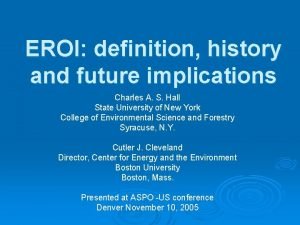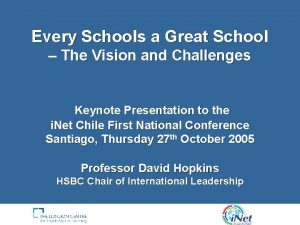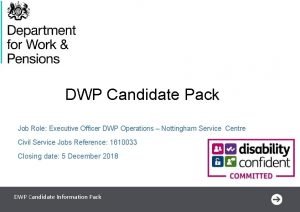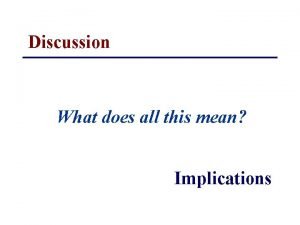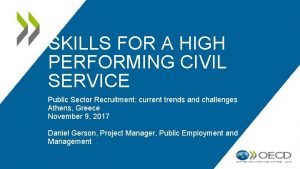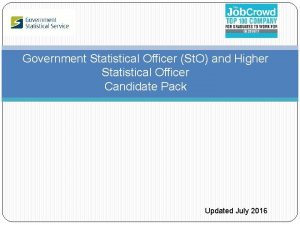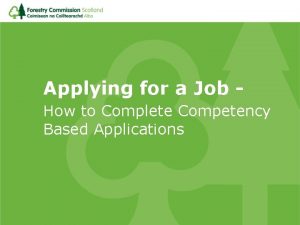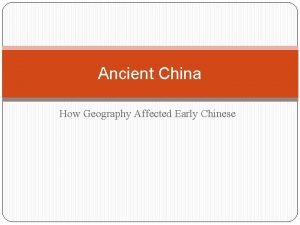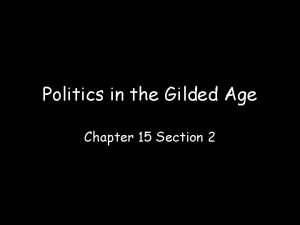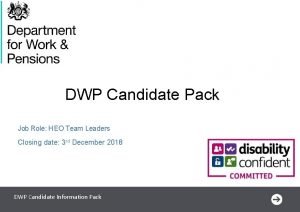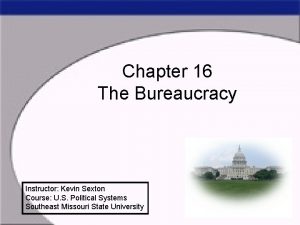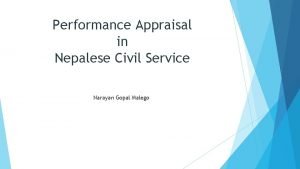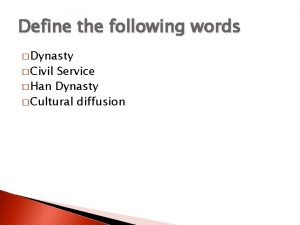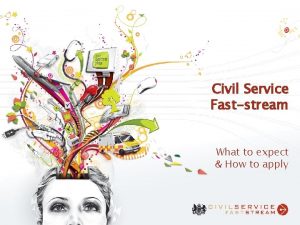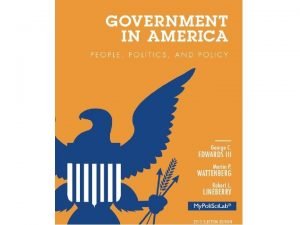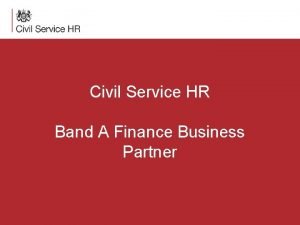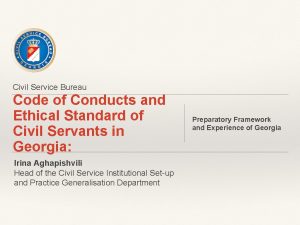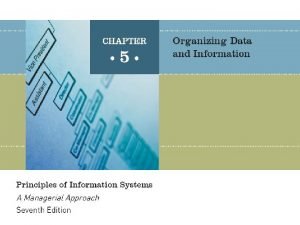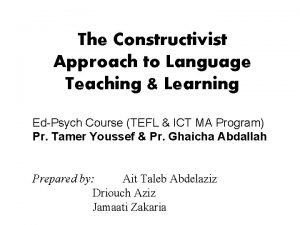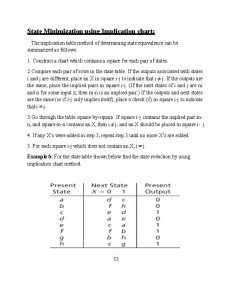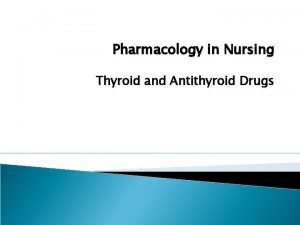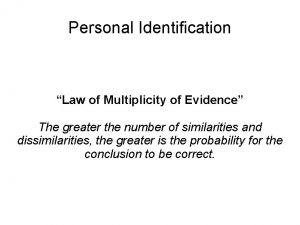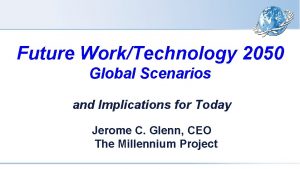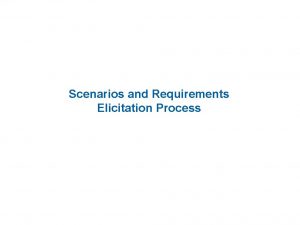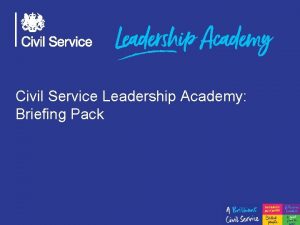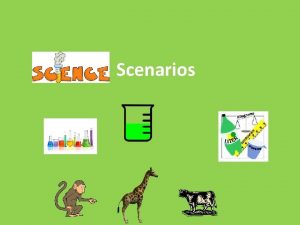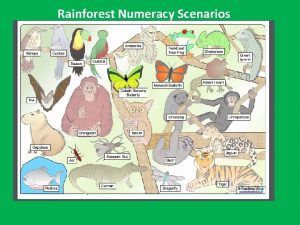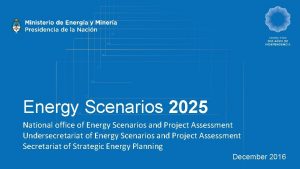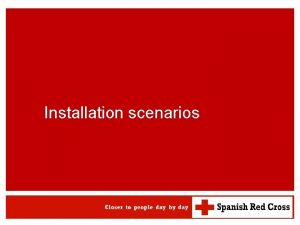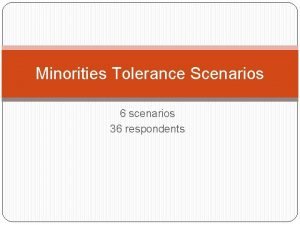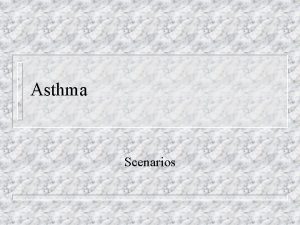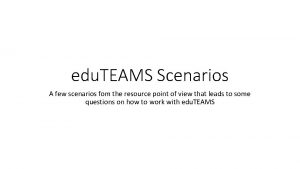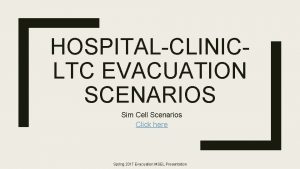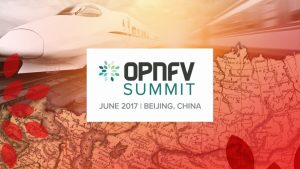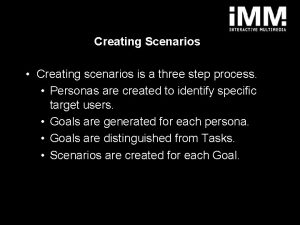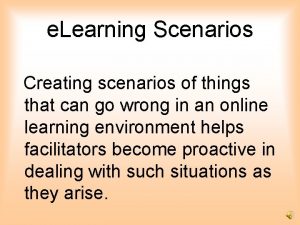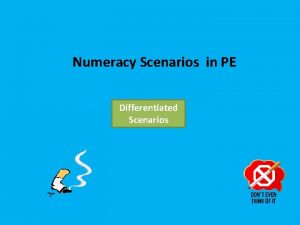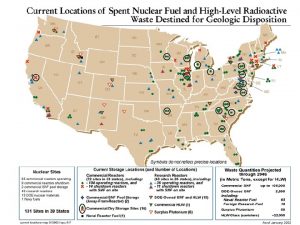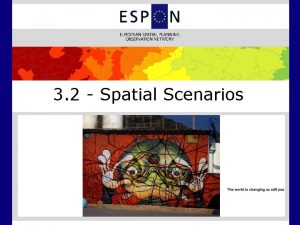Scenarios for the future civil service and implications


































- Slides: 34

Scenarios for the future civil service and implications for scientists and engineers 2 November 2012 Jane Dowsett Innovation Space Beth Hogben GO-Science Martin Duckworth HSC Support Review of the science and engineering profession in the Civil Service – Annex I Government Science and Engineering Network and Horizon Scanning Centre

Agenda 1300 START • Welcome, introductions and objectives • Five people in the GSE network • Four Scenarios • Group work to consider what each scenario means for scientist and engineers – What should individuals do for themselves? BREAK • Implications. What do the scenarios mean for the civil service? • Discussion of actions – What should the profession do? – What should civil service organisations do? 1600 END

Civil Service Reform has implications for all professions Francis Maude: “flatter, faster, more digital, more unified, with better capabilities and performance management, focused on outcomes not process, with modern terms and conditions, and which is more enjoyable to work for. ” Key actions announced June 2012: • More rigorous performance management • Strengthening capability • Unified Civil Service • New ways of delivering services • Creating a modern employment offer for staff • Open policy making

Our people offer valuable skills and expertise to today’s civil service Leadership/Accountability Openness Professional integrity (speak truth to power) Networks with wider science and engineering community for learning, collaboration and advice Motivated by public service and intellectual challenge Assurance of science and engineering activity Communication of government science and engineering activity for transparency and growth Pipeline of people with critical thinking and analytical perspective into Civil Service leadership positions World renown, credible and respected - gateway for dialogue with industry, academia and international expertise Unified Skills Ho. SEP network across all major science and engineering civil service organisations Deep knowledge in a wide range of areas (some known gaps) GSE – excellent foundation for sharing knowledge and know-how Translation of policy issues into research questions and translation of results into advice on implications Roles in all spheres of CS activity (operations, policy, PPM) Professional identity emphasising collaboration, openness and transparency Knowledge of the political, legislative and operational context for advice Support for career development

Focal question for the project How will the working environment, employment models and career prospects of civil service professional experts within government evolve over the next ten years to 2022? 5

Themes for discussion • What kind of knowledge, skills and expertise (in the broadest sense) will be important in the civil service of the future? • What models of access and supply of expertise will we have? • What does it mean for career opportunities? • What systems and processes (HR and IT) will be needed in order to develop and deploy expertise effectively? • What does it mean for leadership in the profession? In the civil service as a whole?

CHARACTERS

Five hypothetical GSE members • Alice: young science Ph. D with industrial experience • Brian: engineer using expertise in contracts and project management • Clive: Chartered engineer in operational delivery • David: science graduate, now civil service “generalist” in a policy role • Emily: technical team leader with a science background

Alice Toxicologist in Health and Safety Executive • 20’s • Ph. D and industrial experience, in an area core to the work of the department • Recruited from industry for her specific science knowledge and skills, which she uses in her day-to-day job • Topic specialist practitioner in operational delivery

Brian Contracts manager in Df. T • 50’s • Engineer by training • His engineering discipline is a core function of his department, directly related to the work and output of the department • Recruited from industry many years ago • Brian now uses his engineering background in contracts negotiation and project management • Programme / project manager, who sees his role as a facilitator

Clive Electronic Engineer in Mo. D • 40’s • Chartered engineer, using his skills in his job • He uses his engineering discipline to support the delivery of departmental functions (e. g. designing, developing and supporting systems and services) • Joined civil service as an engineering apprentice and achieved professional qualifications and chartered engineer status through training on the job • Topic specialist. Practitioner in operational delivery

David Expert in Health Policy (gained in DH and Df. ID) • Late 50’s • Scientist by training, he joined from academia • Ph. D topic is no longer relevant to his work in the department, but he uses his scientific understanding and background to help in his current job of policy development • After a variety of roles across Whitehall, David is now a civil service “generalist” and is a member of the policy profession with frequent contact with ministers. • He sees himself as an advocate for better use of evidence in decision making.

Emily Defra Evidence programme leader on biodiversity • 40’s • Science graduate entrant to civil service • Her science discipline is a useful background to her work but she works with experts from a range of disciplines to support the core functions of the department. • Current role is a technical team leader of a science-based team in a policy sphere. • She takes steps to keep up with scientific developments in her area and has current skills in great demand.

SCENARIOS

Summary of scenarios No X Y Z Working Title Summary Use of expert skills Lean Government Continuous improvement and Efficiency through automation deliver year- technology and crosson-year increases in departmental working workforce productivity Slim down and divest Slimmed down government through divesting functions and comprehensive outsourcing Investment for growth Resourced released by The focus of Reform Plan redeployed government changes to to supporting public investment programme Many skills and services have been outsourced to specialist providers 15

Size of UK civil service Civil Service Reform Plan Expected 23% cut in size of civil service between 2010 and 2015 2010 Year 2015 2020 16

X. Lean Government • Continuous improvement philosophy delivers year-on-year increases in workforce productivity. Outputs maintained with fewer people. • Widespread automation of service delivery. • Technology used effectively internally to transform working practices and the process of government. • Interaction with 99% of the population now served by a single integrated smart-phone App. • Expert skills applied more efficiently and more flexibly across departments. • Less subcontracting, with more work done in-house. 17

Size of UK civil service X. Lean Government Further 23% cut between 2015 and 2022 2010 Year 2015 2020 18

Y. “Slim down and Divest” • Civil service reforms achieve 2012 target reductions (23% by 2015) with difficulty. Comparisons with private industry productivity prove unwarranted. • Ongoing political requirement to reduce headcount. • Extensive privatisation and outsourcing of central government functions. • Divesting of authority to local government or to EU agencies • Technology used to automate but not reinvent 2012 procedures and processes. • Specialist expertise contracted out. Work requiring graduate level skills is often outsourced within contractors to offshore low-cost subsidiaries. 19

Size of UK civil service Y. “Slim down and Divest” costs Further 23% cut in headcount by 2022, but total cost static after 2015 headcount 2010 Year 2015 2020 20

Z. “Investment for growth” • With low interest rates and the continued drive for economic growth, the priority shifts to the UK’s long-term competitiveness. • Government focus changes towards public investment. – Infrastructure, education and the UK’s science base. • Civil service capacity released by further reforms after 2012 has been redirected to support this programme. • Technology used internally to automate 2012 procedures, but not transform the process of government. Interaction with the public now fully automated but on a department-bydepartment basis, with locally tailored systems. • Increased demand for commercial and technical skills to manage, and sometimes to deliver, public investment programmes. 21

Size of UK civil service Z. “Investment for growth” Increasing efficiency means fewer people needed per unit of output, like Scenario X 2010 Year 2015 2020 22

Size of UK civil service Z. “Investment for growth” But increased outputs reflecting increased national investment 2010 Year 2015 2020 23

Size of UK civil service Z. “Investment for growth” But increased outputs reflecting increased national investment Growth in number of scientists and engineers after 2015 to service increased outputs 2010 Year 2015 2020 24

Scenario Groups • We need to divide into three groups of roughly equal size • If you have a strong preference for one scenario, then please move towards the area designated for that scenario • If you have that no strong preference for any scenario, then please move towards the centre of the room • We will choose a dividing point to create three equal-sized groups • Please listen to the instructions

EXERCISE 1 What does this scenario mean for the 5 characters A – E? IMPLICATIONS IN THE FUTURE • What are the implications of your future scenario for each character? IMPLICATIONS TODAY • If the character knew what was going to happen, what are the implications for them today? – What does this mean for their situation today? – What skills and career choices should they consider? • What should this character do now? Please use the Think Tank software to input your ideas

Plenary Discussion CHARACTERS • What are the implications of the scenarios for each character? • What does this mean for their situation today? • What skills and career choices should they consider? • What should this character do now? – What should individuals do for themselves? – Possible proactive actions?

Plenary Discussion • Alice: young science Ph. D with industrial experience • Brian: engineer using expertise in contracts and project management • Clive: Chartered engineer in operational delivery • David: science graduate, now civil service “generalist” in a policy role • Emily: technical team leader with a science background

TEA BREAK

Agenda 1300 START • Welcome, introductions and objectives • Five people in the GSE network • Four Scenarios • Group work to consider what each scenario means for scientist and engineers – What should individuals do for themselves? BREAK • Implications. What do the scenarios mean for the civil service? • Discussion of actions – What should the profession do? – What should civil service organisations do? 1600 END

EXERCISE 2 What does this scenario mean for the civil service? What does this scenario mean for scientists and engineers? Discussion themes: 1. What kind of knowledge, skills and expertise (in the broadest sense) will be important in the civil service of the future? 2. What models of access and supply of expertise will we have? 3. What does it mean for career opportunities? 4. What systems and processes (HR and IT) will be needed in order to develop and deploy expertise effectively? 5. What does it mean for leadership in the profession? In the civil service as a whole? Please use the wallcharts to capture your thoughts and feed them back to the other two groups.

Civil Service professional networks Plenary Discussion Given the different possible futures shown in the scenarios, what does this mean for the network today? • What should the professional network do? • What advice should the professional network offer its members? • What should civil service organisations do?

Next steps • Feedback on scenarios and share with other professions • Analysis of implications will inform recommendations to head of profession and senior network • Publication of report – December 2012 • Follow up to ensure implementation

THANK YOU
 Future implications definition
Future implications definition Future perfect vs future continuous
Future perfect vs future continuous Esercizi future continuous e future perfect
Esercizi future continuous e future perfect Civil rights webquest
Civil rights webquest Oecd scenarios for the future of schooling
Oecd scenarios for the future of schooling Civil service modernised terms and conditions
Civil service modernised terms and conditions Executive officer dwp
Executive officer dwp Discussion and implications
Discussion and implications See future continuous
See future continuous Tenses chart
Tenses chart Future plans and finished future actions
Future plans and finished future actions Perfect future continuous tense
Perfect future continuous tense Kondicional engleski
Kondicional engleski Daniel gerson oecd
Daniel gerson oecd Statistical officer
Statistical officer Dwp heo salary
Dwp heo salary Civil service competency examples
Civil service competency examples Civil service of ancient han
Civil service of ancient han Chapter 15 section 3 politics in the gilded age
Chapter 15 section 3 politics in the gilded age Heo dwp jobs
Heo dwp jobs Dan sexton civil service
Dan sexton civil service The pool talent management
The pool talent management Civil service performance appraisal examples
Civil service performance appraisal examples Civil service han dynasty
Civil service han dynasty Civil service fast stream competencies
Civil service fast stream competencies Civil sports club
Civil sports club Civil service seeing the big picture example
Civil service seeing the big picture example Bristol civil service sports club
Bristol civil service sports club Finance business partner civil service
Finance business partner civil service Civil service bureau georgia
Civil service bureau georgia Implications of database approach
Implications of database approach Constructivist approach to language learning
Constructivist approach to language learning Implications table
Implications table Nursing implications for synthroid
Nursing implications for synthroid Multiplicity of evidence
Multiplicity of evidence
